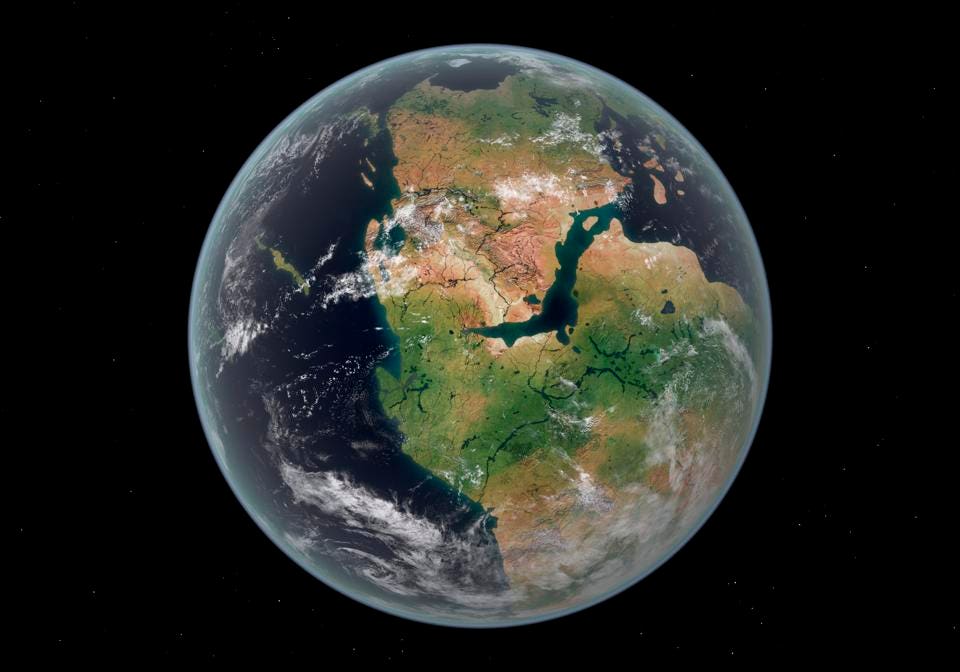According to the convention of many geographical organizations, the Earth today has a total of 7 continents. However, according to the prediction of geophysicist Ross Mitchell, in the future, the Earth will have only 1 continent.
This prediction actually appeared in a book called "The Next Supercontinent" written by him.
In the book, geophysicist Ross Mitchell describes the Earth about 200-300 million years ago, when the closest supercontinent on Earth existed - the supercontinent Pangaea, located in what is now Africa.
Next, the geophysicist describes the supercontinent Rodinia, which formed about 1 billion years ago, located in what is now North America. And describes the first supercontinent on Earth, called Columbia, located in what is now Siberia.

Simulated image of the supercontinent Pangea, stretching from the North Pole to the South Pole (Source: GETTY).
Relying on geological activities from the past to track the displacements that are occurring today requires scientists to have highly specialized activities.
These activities often begin with the collection of specimens that can determine the time of rock formation, as well as the latitude at which the specimens were collected.
The clues that help scientists explain why supercontinents formed in the first place, and why they continuously "merge and emerge", lie in many different fields of research.
In one area of study, scientists describe the geological layers of the Earth.
In general, the Earth can be said to consist of three geological layers: the crust, the mantle, and the core. Over the years, the mantle has had activities that have impacted the continents. Scientists describe this mantle as hard yet soft.
The mantle lies between and also controls the relationship between the Earth's crust and the core - where heat is stored.
According to geophysicist Ross Mitchell, the loop of supercontinent formation on Earth is tied to the geological activity of the mantle carrying heat from the core to the Earth's crust.
Scientists believe that as it warms, continents will move toward cooler mantles.
Those colder regions appear when oceanic plates sink below tectonic plates and into the mantle.
Little by little, the sinking oceanic plate will pull the tectonic plates closer together, leading to the formation of a supercontinent.
After the continents "merge" into a supercontinent, the pull from deep within the Earth will stop, but somewhere inside the supercontinent, the hot mantle carrying the heat of the Earth's core will churn again and tear the supercontinent apart into continents. This cycle continues over and over again.

Simulation of Earth with the Eurasian supercontinent (Source: NICOLLE R. FULLER/SCIENCE SOURCE).
Based on what happened in the past, geophysicist Ross Mitchell predicts that the next supercontinent on Earth will occur in about 200 million years when Asia and America merge, called Asia - America - Amasia.
Researchers believe this supercontinent will appear when the Pacific or Atlantic Ocean disappears.
For Ross Mitchell, he suggested that the supercontinent Amasia would form as the Arctic Ocean began to disappear, Europe and Asia would begin to stick together from the North Pole, gradually pulling the rest of the continents together.
According to the US National Oceanic and Atmospheric Administration, tectonic plates are moving at an average rate of about 1.5cm per year, equivalent to the growth rate of human fingernails.
Some regions, like coastal California, are moving faster, about 5cm per year; but Ross Mitchell's prediction will only be verified by our descendants.

Source








![[Video] Official opening of Da Nang International Fireworks Festival 2025](https://vphoto.vietnam.vn/thumb/402x226/vietnam/resource/IMAGE/2025/6/2/494a76aa665f46b1be7b3f43e682f5b6)























































































Comment (0)